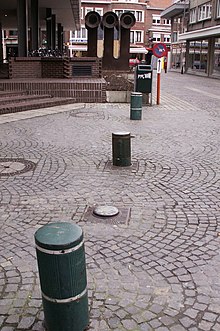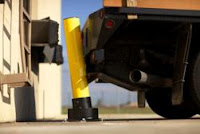 This post will be part of a five part article which
describes traffic bollards types and their typical uses. In this post, I’ll discuss bollard types and
introduce the four main uses for traffic bollards.
This post will be part of a five part article which
describes traffic bollards types and their typical uses. In this post, I’ll discuss bollard types and
introduce the four main uses for traffic bollards.
Traffic bollards come in four main types:
- Embedded Bollards
- Surface Mounted Bollards
- Rebounding Bollards
- Retractable / Removable Bollards
Each type is specifically designed for its purpose and has
its own benefits and limitations. Within
those groups, there are sub-groups which I will discuss as well. Also, bollards that fit in those categories
can also fall into other sub-categories less dependent on function and more on
aesthetics. Architectural Bollards might
be any of the above, but are also designed to also include pleasant or unique
shapes. A Lighted Bollard is simply a
bollard with a light source built in either to add conspicuity to the bollard
or to light the surrounding area.
Embedded Bollards
Embedded Bollards are simply bollards which are embedded
deep into the ground. This is usually
for added
strength and security.
Embedded bollards can be made out of any common bollard material, be it
steel, concrete or even wood, however the bollard will only be as strong as the
foundation in which it is buried.
A steel post filled with concrete and buried very deep
within a reinforced concrete foundation will be strong indeed. On the contrary, a wooden post buried in soft
sand or dirt will not provide as much protection.
Costs for this type of bollard can be significant when
coring out existing concrete or asphalt surfaces. It also potentially weakens the foundation,
and therefore may not even be appropriate in an application such as a
structural concrete parking deck. On the
other hand, when placing a bollard in an unpaved area, this is perhaps the least
expensive and simplest approach.
Surface Mounted
Bollards
 This type of bollard uses some sort of anchor system, usually
mechanical, to mount the bollard to the surface. Although this is an inexpensive method of
installation, it also is not a very secure method. Upon impact, the anchors are often the
weakest link and quickly give way, leaving a tilted bollard and damaged
foundation. However, when the purpose of
the bollard is more to provide a mere presence or psychological barrier, this
type of installation is most cost effective.
It also may be necessary to use shear bolts in a post-tensioned concrete
structure in order to prevent impact to the bollard to potentially compromise the
building.
This type of bollard uses some sort of anchor system, usually
mechanical, to mount the bollard to the surface. Although this is an inexpensive method of
installation, it also is not a very secure method. Upon impact, the anchors are often the
weakest link and quickly give way, leaving a tilted bollard and damaged
foundation. However, when the purpose of
the bollard is more to provide a mere presence or psychological barrier, this
type of installation is most cost effective.
It also may be necessary to use shear bolts in a post-tensioned concrete
structure in order to prevent impact to the bollard to potentially compromise the
building.
The next type of bollard, the rebounding bollard, is often
surface mounted, but overcomes the strength and damage issues associated with
standard surface mounted bollards.
Rebounding Bollards
 A relative newcomer to the bollard field, rebounding bollards use energy absorption technology
to provide
A relative newcomer to the bollard field, rebounding bollards use energy absorption technology
to provide
A further advantage of this type of system is that damage to
vehicles, passengers and loads is reduced due to the more gradual absorption of
impact energy. Imagine crashing a
vehicle into a large concrete bollard.
Since there is almost no give, it is much like hitting the proverbial
brick wall; all energy is immediately felt by the vehicle and its
passengers. With a flexible bollard
system, that energy might be dispersed over several hundred milliseconds. While that doesn't sound like much, it makes
a great deal of difference to the peak forces felt.
Some bollards in this type are actually not intended to
provide traffic denial capabilities at all.
As such, they are used mainly as sign markers and psychological
barriers. These are extremely prevalent
in the United Kingdom.
Retractable / Removable
Bollards
Not all applications for bollards are intended to be
permanent or always prevent access. As
such, retractable
and removable bollards have been designed to allow the owner or a potential
traveler access the area normally denied by the bollard.
 |
| From Wikipedia.org |
This is typically done in one of several ways. The lowest technology is the pipe-in-a-tube
method where a socket is created in the ground.
The bollard can then be removed from the socket when access is to be
granted. This is inexpensive, but
requires manual intervention to access the area.
A second way is through the use of pivoting bollards. A locking pin is used to hold the bollard
upright under normal circumstances, and removed to allow the bollard to lay
flat when a vehicle is to pass over it.
These bollards are generally flat in shape to allow for vehicle
clearance. Often, the pin is locked in
place with a padlock to prevent unauthorized access.
Finally, the most expensive method is the automatic
retractable bollard. Usually hydraulic
powered, the bollard actually retracts straight down into the ground and
becomes flush with the surface during access.
Actuation of a hydraulic bollard can be by any number of methods, from
security guard push button to remote controls and toll booth pay systems.
Uses of Bollards
In the next four parts of this article, I’ll discuss ideal
uses for bollards for each of the following areas of concern:
- Traffic Denial
- Parking Lot Protection
- Drive-Thru Lanes
- Factories and Warehouses
Certain types of bollards I discussed today are more or less
appropriate for each application, depending on the required function. I’ll discuss that in detail for each type.








.1008.jpg)












